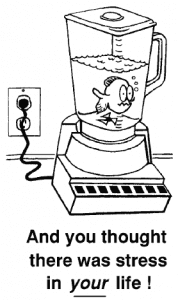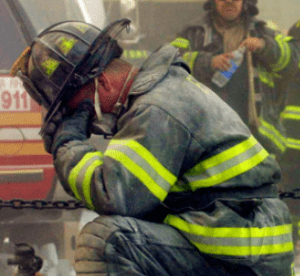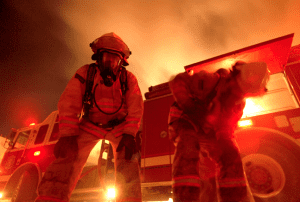 Welcome to Part 2 of my series on stress. The goal of this segment is to discuss three types of stress: Acute stress, episodic acute stress and chronic stress. Anyone on an emergency scene can, and often do, experience all three. Stress can impact situational awareness and, equally concerning, stress can have devastating long-term impacts.
Welcome to Part 2 of my series on stress. The goal of this segment is to discuss three types of stress: Acute stress, episodic acute stress and chronic stress. Anyone on an emergency scene can, and often do, experience all three. Stress can impact situational awareness and, equally concerning, stress can have devastating long-term impacts.
As I was doing my research for this segment, I had more than my share of flashbacks from my thirty years on the line. Responders are aware of the stresses that come from doing this job. Crawl into a burning building and you’re going to feel stress. Deal with a traumatized human body (especially a child) and you’re going to experience stress. Ride in a vehicle in heavy traffic during an emergency response and you’re going to feel stress.
However, some people don’t realize when they’re feeling stress because stress doesn’t always feel like, well, stress. Endorphins and adrenaline stimulate the brain (in preparation for Fight or Flight). This stimulation can cause you to feel excited, not stressed. Firefighters exit a structure after successfully extinguishing a fire. VICTORY! They high-five. They back-slap. They’ve slayed the dragon! They are excited. They are also stressed. Let’s examine three kinds of stress.
Types of stress
The most common form of stress you are likely to experience in your daily lives is acute stress. It manifests from things that have happened recently or from things that are about to happen (stress from anticipation). So long as the amount of acute stress is limited, it may cause you to feel excitement or exhilaration. However, large doses of acute stress is not exhilarating. It’s exhausting.
I experienced both ends of the acute stress spectrum this past summer while on a family vacation to Cedar Point Amusement Park. There, I got to ride an amazing roller coaster called Top Thrill Dragster. ‘Keep your arms down, head back, and hold on’ are the last words I remember hearing before I was launched down a track to 120 miles per hour. Then I was vaulted 420 feet into the air and back down again. Start to finish it was 17 seconds of sheer terror. I was experiencing acute stress. But it sure didn’t feel like stress. I LOVED IT!
While waiting in the 1.5 hour long line to get on the ride I observe the faces and heard the screams of the stressed riders preceding me. This anticipation added to my level of acute stress.
As the day went on and I rode more and more roller coasters I started to experience the physical and psychological symptoms of my stress. I got a tension headache, an upset stomach, my muscles were aching and much to the disdain of my kids, I had become irritable. I had been overexposed – you might say I overdosed – on acute stress.
Because of its short-term nature, acute stress doesn’t have enough time to do the extensive damage associated with long-term stress. Symptoms of acute stress may include:
- Anger
- Irritability
- Anxiety
- Depression
- Tension headache
- Back pain
- Jaw pain
- Muscle tension
- stomach aches
- Heartburn
- Acid stomach
- Flatulence
- Diarrhea
- Constipation
- Irritable bowel syndrome
- Elevation in blood pressure
- Rapid heartbeat
- Sweaty palms
- Heart palpitations
- Dizziness
- Migraine headaches
- Cold hands or feet
- Shortness of breath
- Chest pain
Because the list is so extensive and the symptoms can result from many other conditions, it is common for the symptoms of acute stress to be attributed to other causes.
Anyone can experience acute stress at any time. But first responders and people who work in any dangerous profession, by the nature of their work and working conditions, are more likely to experience acute stress. The good news is, acute stress is highly treatable and manageable.
Episodic acute stress
Episodic acute stress occurs in people who suffer frequent bouts of acute stress. People in this category are often referred to as having lives filled with chaos and crisis. Always being in a rush. Always worrying about what can go wrong. Always being in an environment that is in disarray. Having high demands placed in them (by others or their own expectations) can all attribute to episodic acute stress.
While a first responders and people in other highly jobs, personal lives may not be filled with chaos and crisis, he or she can be exposed to much more than the average person’s quota of stress. Chaos and crisis, being rushed, worrying about things going wrong (for their own safety and the safety of those they are serving), working in rapidly changing environments and having high demands being placed on them (by elected officials, bosses, peers, and customers) are all part and parcel to the normal environment of people in these high stress jobs. Even where these employees may have his or her personal life in order, the job itself can create episodic acute stress.
Imagine a person being in an environment that is excessively noisy, or bright, or cold, or windy. Repetitive and/or lengthy exposure to those elements is going to create stress. First responders who are repetitively exposed to lights and sirens, harsh environments and psychological trauma may suffer from episodic acute stress from repetitive and/or lengthy exposures.
The symptoms and consequences of episodic acute stress can include:
- Being over aroused
- Short tempered
- Irritable
- Anxious
- Tense
- Nervous energy
- Feeling (and acting) rushed
- Abrupt
- Hostile
- Hypertension
- Chest pains
- Heart disease
Ironically, being exposed to someone exhibiting the symptoms of episodic acute stress can, in turn, increase the stress levels of those within their circle of influence. It can truly be a vicious circle.
Personalities
Episodic acute stress can be compounded by ‘Type A’ personalities. Type A’s are known for being competitive, impatient and having an ever-present sense of urgency to everything, Type A’s are often aggressive and seemingly hostile – sometimes mildly, sometimes not.
Research into the cardiac impact of stress has revealed Type A’s are far more likely to develop coronary artery disease as compared to the more docile, laid-back, relaxed ‘Type B’ personality counterparts. For better or worse, the action-oriented, fast-paced, high adrenaline rush inducing environment of public safety is a magnet for Type A’s.
Episodic acute stress can be manifested from chronic worry also. People in high-stress jobs can be lulled into worrying about the unfavorable outcomes of everyday situations because they are exposed, repetitively, to people who are experiencing unfavorable outcomes in the throws of living everyday lives. For example:
A mother and her young son are walking down the sidewalk. An inattentive driver veers off course. The mother sees the car and instinctively jumps, avoiding being struck. But her seven year-old son is struck by the car and suffers major head and thoracic injuries. He may not survive. Traumatic for the family. Traumatic for the inattentive driver who caused the accident. And traumatic for the first responders – police, fire and EMS who had to manage a crisis they did not create.
The world we live in can be dangerous and bad things can happen with no forewarning. First responders see the consequence of this almost daily and it can not only have a cumulative effect, it can make the responder overly worrisome about the same consequences occurring in his or her own life or to his or her loved ones. This can contribute to stress-induced anxiety and depression.
Unlike acute stress which is short term and relatively easy to manage, episodic acute stress requires intervention that can include help from professional therapists. Treatment can last months or years.
Lifestyles
The first responders lifestyle, or anyone in a high-stress job or environment – always being in the fast lane of life and the middle of the action – can be addicting. It can became ingrained and habitual. These people may see nothing wrong with their ‘pedal to the metal’ lifestyle. They may never be able to see the impact stress is having on them. If they do see it, they’re likely to blame it on one someone else or on external events.
Pride and ego can also be a factor. A responder, for instance, is used to being a care-giver, not a care-receiver and may be too proud to ask for help. He or she may also simply concede that the stress of their job is just part of who they are and what they do and resign themselves that nothing can be done about it.
Victims of episodic acute stress can be very resistant to admitting they have a problem and very resistant to changing anything in their lives to fix the problem. If their job-stress is compounded by (or maybe even exaggerated by) obesity, alcohol abuse, smoking, and/or a sedentary lifestyle, they may be very stubborn to change habits or seek help.
Chronic stress is never thrilling and never exciting. It eats away at you every day, year after year and it can be tremendously destructive. Chronic stress occurs when a person is in a repetitively stressful environment can’t see any way out of their situation. They feel trapped – so hopeless and so helpless they’ll actually give up on trying to find a solution.
The chronic exposure to stress over long periods of time can lead to desensitization. The stressed individual may become so accustomed to being stressed that they no long feel stressed. They’re numb. They can, however, still feel the excitation and exhilaration of acute stress because acute stress is novel (new) while still ignoring the chronic stress.
Left undiagnosed and untreated, chronic stress can lead to depression and suicide. The occurrence of a suicide is very painful for family and co-workers. We’re all taught to be care-givers, to help others and when we lose one of our own we can feel tremendous guilt and remorse that we could not see it coming. Sometimes there are signs and symptoms, often times there are not. For more on this topic, I refer readers to the following resources:
Suicide Prevention Resource Center
Preventing suicide: A resource for police, firefighters and other first line responders
Sadly, a person can become so used to the feeling of chronic stress that he or she will actually feel uncomfortable when not in their stressful environment. I have seen this. Ok… I have experienced this. There have been many times when I was so stressed at work that I needed a vacation and took one. While on vacation I felt uneasy and, for reasons hard to explain, yearned to be back at work in the very pressure-cooker environment I took the vacation to get away from. I had become comfortable in my chronic stress environment.
My personal wake-up call came when I retired from active public service. It was hard to be out of the stress environment. I felt lost for weeks. But then something amazing, almost magical, started to happen to me. My migraine headaches went away. My tensed muscles relaxed. My acid reflux symptoms ceased. I slept through the night. I’d never felt this level of relaxation anytime in my 30 years of public safety service.
Looking back, I was a heart attack or stroke just looking for a place to happen. The denial of my stress, coupled with my sedentary lifestyle had led to morbid obesity, high cholesterol, hypertension, acid reflux, sleep apnea, shortness of breath, blurred vision and excessive flatulence.
I’ve lost 60 pounds and every symptom resolved… except one. I blame the broccoli.
About the Author
Richard B. Gasaway, PhD, CSP is widely considered a trusted authority on human factors, situational awareness and the high-risk decision making processes used in high-stress, high consequence work environments. He served 33 years on the front lines as a firefighter, EMT-Paramedic, company officer, training officer, fire chief and emergency incident commander. His doctoral research included the study of cognitive neuroscience to understand how human factors flaw situational awareness and impact high-risk decision making.
_____________________________________________________

If you are interested in taking your understanding of situational awareness and high-risk decision making to a higher level, check out the Situational Awareness Matters Online Academy.
CLICK HERE for details, enrollment options and pricing.
__________________________________
Share your comments on this article in the “Leave a Reply” box below. If you want to send me incident pictures, videos or have an idea you’d like me to research and write about, contact me. I really enjoy getting feedback and supportive messages from fellow first responders. It gives me the energy to work harder for you.
Let’s Get connected
Facebook: SAMatters
LinkedIn: Rich Gasaway
LinkedIn: Situational Awareness Matters
Twitter: Rich Gasaway
Youtube: SAMattersTV
itunes: SAMatters Radio
Stitcher Radio: SAMatters Radio
Google Play: SAMatters Radio
iHeart Radio: SAMatters Radio



Pingback: Stress: The Nemesis of Situational Awareness | Situational Awareness Matters!™
Pingback: Searching for a “new normal” | Iron Firemen
Pingback: Stress: The Nemesis of Situational Awareness | Situational Awareness Matters